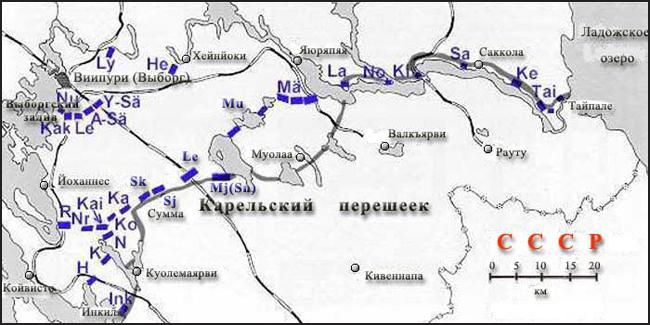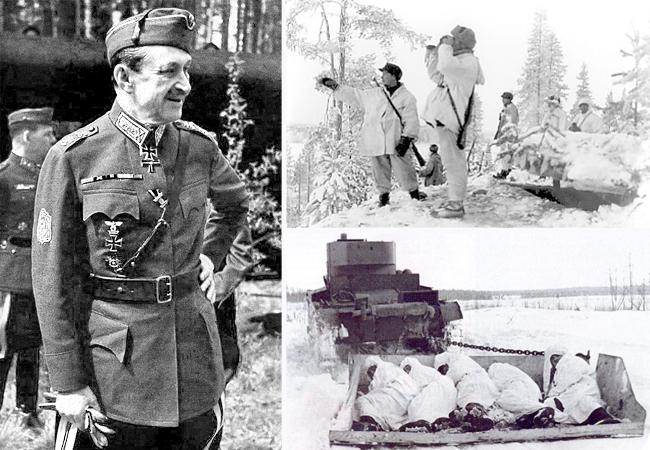An object that arouses genuine and constant interest in many generations of people is the Mannerheim complex of protective barriers. The Finnish defense line is located on the Karelian Isthmus. It consists of many bunkers blown up and strewn with traces of shells, rows of stone grooves, dug trenches and anti-tank ditches - all this is well preserved, despite the fact that more than 70 years have passed.
Reasons for the war
The reason for the military conflict between the USSR and Finland was the need to ensure the security of the city of Leningrad, since it was located near the Finnish border. On the eve of World War II, the Finnish leadership was ready to provide its territory as a springboard for numerous enemies of the Soviet Union, and mainly for Nazi Germany.

The fact is that in 1931 Leningrad was transferred to the status of a city of republican significance, and part of the territories subordinated to the Leningrad City Council turned out to be simultaneously the border with Finland. That is why the Soviet leadership and began negotiations with this country, inviting her to exchange land. The Soviets proposed a territory twice as large as they wanted in return. A stumbling block in the agreements was a clause asking the USSR to deploy its military bases on Finnish soil. But the parties did not agree, which led to the beginning of the Soviet-Finnish, or the so-called Winter War. If it weren’t for her, Leningrad would have been captured by Hitler’s troops at the beginning of World War II in just a few days.
Background
The concept of "Mannerheim Line" refers to a whole complex of historical defensive structures that played a major role in the Soviet-Finnish War. It lasted from November 30, 1939 to March 13, 1940.

As soon as Finland gained independence, it immediately began to think about strengthening its borders, and already at the beginning of 1918 the construction of barbed wire fences began on the site of the future grand military shield of Mannerheim. The line was finally approved in 1920 and was first named the “Enkel Line” in honor of the major general O. L. Enkel, who was then chief of the General Staff, who directed its construction. The developer of the fortifications was the French officer J.J. Gross-Kaussi, who was sent to Finland to help strengthen the borders of this country. But, following the traditions already established at that time, the complexes of defensive structures were most often named after the "big bosses", for example, Stalin Line or Maginot. Therefore, in order to avoid confusion, these barriers were renamed and named after the Commander-in-Chief of the Finnish Republic Karl Gustav Mannerheim, a former officer of the Russian army.
Finland Shield
The Mannerheim Line is a 135 km long defensive line that has completely crossed the entire Karelian Isthmus - from the Gulf of Finland to Lake Ladoga. From the west, defense communications passed partly along the plain, and partly along hilly terrain, covering the passages between numerous swamps and small lakes. In the east, the line relied on the Vuoksinskaya water system, which in itself was a serious obstacle. Thus, in the period from 1920 to 1924, the Finns built more than one and a half hundred long-term military structures.
By the end of 1927, it became clear that Enkel’s engineering barriers were significantly inferior to Soviet defensive fortifications in terms of building quality and armament, so their construction was temporarily suspended. In the 30s, the construction of long-term structures was resumed again. They were erected a little, but they became much more powerful and more complicated.
In the early 30s, Mannerheim was appointed to the post of chairman of the Council of State Defense. The line has since been built under his leadership.
Defensive Structures - Bunkers
The main restraining strip was defense units, which consisted of several concrete pillboxes (long-range firing points), as well as bunkers (wood-earthen firing points), machine-gun nests, dugouts and rifle trenches. Along the line of defense, strong points were placed extremely unevenly, and the distance between them sometimes even reached 6-8 km.
As you know, military construction lasted more than one year, therefore, by the time of construction of the bunkers are divided into two generations. The first includes firing points built in the period from 1920 to 1937, and the second - 1938-39. First-generation pillboxes are small fortifications designed to mount only 1-2 machine guns. They were not adequately equipped and did not have shelters for soldiers. The thickness of concrete walls and ceilings did not exceed 2 m. Later, most of them were modernized.
The so-called millionaires belong to the second generation, since their cost cost the Finnish people 1 million Finnish marks each. Only 7 such powerful firing points had the Mannerheim Line. Millionaire bunkers were the most modern reinforced concrete structures equipped with 4-6 embrasures, of which 1-2 were guns. The most formidable and most fortified were considered bunkers Sj-4 “Poppius” and Sj-5 “Millionaire”.
All long-term firing points were carefully camouflaged by stones and snow, so it was very difficult to detect them, and it was almost impossible to break through their casemates.
Flood zones
In addition to a number of long-term and field fortifications, several zones of artificial flooding were provided. The hostilities that suddenly began prevented them from being completed, but several dams were nevertheless erected. They were made of wood and earth on the rivers Tuyppelyanyoki (now Alexandrovka) and Rokkalanyoki (now Gorokhovka). A concrete dam stood on the Peronjoki River (Perovka River), as well as a small dam on Mayajoki and a dam on Sayyanjoki (now the Volchya River).
Anti-tank barriers
Since there were enough tanks in the arsenal of the USSR, the question of methods of dealing with them was obvious. The wire barriers previously installed on the Karelian Isthmus could not be considered a good obstacle for armored vehicles, so it was decided to knock out gouges from granite and dig out anti-tank ditches with a depth of 1 m and a width of 2.5 m. But, as it turned out during the hostilities, the stone gouges were ineffective. They were displaced or fired from artillery shells. After repeated shelling, granite collapsed, resulting in wide passages.
Finnish sappers installed over 10 rows of antipersonnel and anti-tank mines staggered behind the gouges.
Storm
The winter war is usually divided into two stages. The first lasted from November 30, 1939 to February 10, 1940. The assault on the Mannerheim Line became the most difficult and bloody for the Red Army at that time.
The powerful screening turned out, despite all its shortcomings, to be an almost insurmountable obstacle for Soviet soldiers. In addition to the fierce resistance of the Finnish army, the strongest forty-degree frosts turned out to be a huge problem, which, in the opinion of most historians, became the main reason for the failures of the camp of the Soviets.
February 11 begins the second phase of the winter military campaign - the general offensive of the Red Army. By this time, the maximum amount of military equipment and manpower was pulled to the Karelian Isthmus. Artillery preparation took place for several days, shells rained down on the Finnish positions, which fought under the leadership of Mannerheim. The line and the entire surrounding area were heavily bombarded. Together with the ground units of the North-Western Front, the ships of the Baltic Fleet and the recently formed Ladoga Naval Flotilla participated in the battles.
Breakthrough
The assault on the first defense line lasted three days, and on February 17, the 7th Army finally broke through it, and the Finns were forced to completely abandon their first line and switch to the second, and lost it on February 21-28. The breakthrough of the Mannerheim line was led by Marshal S.K. Timoshenko, who led the North-Western Front by order of I.V. Stalin. Now the 7th and 13th armies, with the support of coastal units of the Baltic Fleet sailors, launched a joint offensive in the strip from Vyborg Bay to Lake Vuoksa. Seeing such an onslaught of the enemy, the Finnish troops left their positions.
As a result, the second breakthrough of the Mannerheim Line ended with the fact that, despite the desperate resistance of the Finns, on March 13 the Red Army entered Vyborg. So ended the Soviet-Finnish war.
War Results
As a result of the Winter War, the USSR achieved everything that it wanted: the country completely took possession of the Lake Ladoga water area, and also part of the Finnish territory of 40 thousand square meters passed to it. km
Now many are wondering: was this war needed? If it were not for the victory in the Finnish campaign, Leningrad could become the first in the list of cities affected by the advance of Nazi Germany.
Tours of the battlefield
Today, most of the buildings are destroyed, but despite this, excursions to the places of the battle of the Winter War are still held, and interest in them does not fade. The surviving strongholds are still of great historical interest - both as military engineering structures, and as the site of the most difficult military battles of this half-forgotten war.
There are historical and cultural centers that develop special programs for following the places where the Mannerheim Line passes. The tour usually includes a story about the stages of its construction, as well as the progress of the battles.
To at least a little feel and feel the life of the Finnish and Soviet armies, a field lunch is organized for tourists. Here you can also take pictures against the backdrop of grandiose structures with elements of equipment, see and hold mock-ups of weapons in your hands.
There are many white spots, hidden events and facts in the history of any military conflicts. The war of the Soviet Union with Finland of 1939-40 was no exception. She lay a difficult test on the shoulders of both sides. In just 105 days, when military operations were carried out, about 150 thousand people were killed, about 20 thousand were missing. Here are the results of this half-forgotten and, according to some historians, "unnecessary" war. As a monument to the fallen soldiers, the Mannerheim Line, unusual in its scale, remained on the battlefield. Photos of those times and stones on mass graves still remind us of the heroism of Soviet and Finnish soldiers.